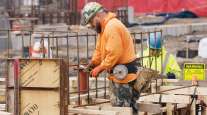Jobs Top Forecast at 263,000 Gain, but Wages Miss Estimates

The U.S. economy accelerated its rebound from a recent soft patch as unemployment unexpectedly fell to a fresh 49-year low amid strong hiring and cooler-than-projected wage gains, suggesting the hot labor market can extend its run.
Payrolls climbed by 263,000 in April after a downwardly revised 189,000 advance the prior month, according to a Labor Department report May 3 that exceeded all estimates in a Bloomberg survey. The jobless rate fell to 3.6% while average hourly earnings growth was unchanged at 3.2%, below projections.
U.S. stock futures extended gains after the report. The fed funds futures market briefly showed a slight reduction in odds for a Federal Reserve rate cut this year, before returning to where it was prior to the data, after calls from President Donald Trump and others for a reduction to support the expansion. Policymakers reiterated their patient stance this week as Chairman Jerome Powell cited “very strong job creation’’ while noting weaker inflation.
JOBS, JOBS, JOBS!
“Jobs surge in April, unemployment rate falls to the lowest since 1969” https://t.co/4DGpumMISf— Donald J. Trump (@realDonaldTrump) May 3, 2019
“It’s clearly telling you this economy is still chugging along very nicely,” Torsten Slok, chief economist at Deutsche Bank Securities, said on Bloomberg Television. “It is inflationary in the sense that wages did go up but they didn’t go up as much as we had expected.”
The surprising overall robustness — which didn’t reflect any surge in temporary hires for the 2020 Census, as some analysts had flagged — follows months of broad labor market strength. While the expansion is poised to become the nation’s longest on record at midyear, economists expect a deceleration this year even after a strong first quarter.
However, the lower unemployment reading was due in part to a factor economists don’t always see as a healthy sign: The participation rate, or share of working-age people in the labor force, decreased to 62.8% from 63%.
Revisions for February and March added 16,000 more jobs than previously reported, while the three-month average fell to 169,000.
The May 3 data follow a Federal Open Market Committee statement May 1 saying “the labor market remains strong.” Officials in March forecast a 3.7% unemployment rate at year end.

The payroll gains were somewhat uneven, with construction, health care, and professional and business services posting gains while retail employment fell by 12,000 for a third straight decline.
Construction payrolls climbed by 33,000, the most since January, as manufacturing employment rose by 4,000. Factory employment was unchanged in the prior month after a previously reported drop.
Average hourly earnings rose 0.2% from the prior month after a revised 0.2% rise in the prior period. Wages for production and nonsupervisory workers accelerated to a 3.4% annual pace, signaling gains for lower-paid employees.
While the historically tight labor market has pushed companies to raise pay, inflation appears largely subdued, as the fatter paychecks don’t show any sign of fueling faster price gains.
At the same time, the average workweek got slightly shorter, boosting average hourly pay. The average for all private employees decreased to 34.4 hours, from 34.5 hours.
While temporary federal government hiring for the Census Bureau’s 2020 count may be poised to give nonfarm payrolls a boost, that wasn’t cited in the Labor Department’s report May 3. Federal employment excluding postal jobs rose by 12,500, still the most since 2010, to 2.21 million.




